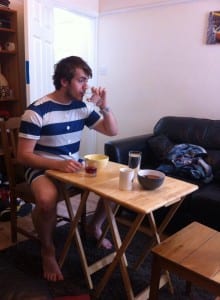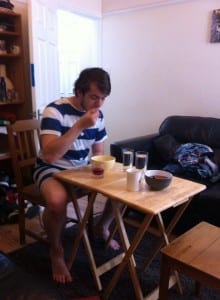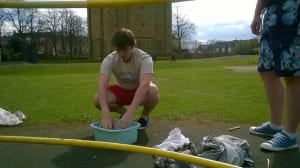Feedback from our trial run.
The main task for this weeks rehearsals was to edit the phrasing of our audio. During the trial run one of the main comments that were given was that we had over scripted the audio and needed to be more suggestive with instructions rather than formal. The audio also apparently sounded quite patronising, which when listening back I can understand. We understood that we would have to guide the audience around with clear instructions, however I think we underestimated how free thinking they would be. We structured the audio far too much and it therefore the piece lost a lot of its freedom. Our whole concept was for the audience to feel as if they are in control and that whatever they believe it right. However due to the over-structred questions and instructions, it lost the essence of our original intentions.
How we built on the constructive criticism.
That night (after the trial run) we all sat around, deflated and feeling a little lost for ideas. We decided that because we were overthinking the audio, we shouldn’t overthink the rehearsal process either. So we started our evening with a casual chat and a gossip to lighten the mood and subsequently ideas for our audio began to flow. We tried writing down a mini scrip but we quickly found that we fell back into what I call ‘sat-nav mode’, where suggestions turned to instructions and we found ourselves back in the same position. We found that comments that we often said flippently and without much thought, ended up being helpful, yet we could never remember them to put in the audio. I then remembered a moment in a completely unrelated film that I had recently watched, Saving Mr Banks (Hancock, 2013). It tells the story of the making of Mary Poppins and I remembered that during the creation process of the film, all conversations during meetings were recorded so they could refer to them at a later date for inspiration. I then suggested the idea to record all of our meetings on my phone so no comments were lost, and that our thought process wasn’t broken when we stopped to write ideas down. This seemed to work brilliantly and was very beneficial. Below is a short snippet of audio from one of our meeting. You can hear the groups thought processes developing:
We then divided the audio into seven separate audios, and each took one or two home to transcript, and put a new script together. Below is the most recent audio:
After another trial run with the new audio, the comments we received back were much better. We also got a friend (who had nothing to do with our site performance) to trail run it for us as well. We followed a few steps behind him and took note of which directions he looked, where he seemed to get confused, if he went off track (which he didn’t thankfully) etc. This was really helpful as it brought a fresh perspective to the piece and highlighted any issues that an actual audience member would encounter.
Relevant research
I was reminded of verbatim theatre during our tasks this week. Recording live, ‘real life’ conversations and creating a transcript for a theatre piece linked with the ideas and practices of verbatim theatre. Will Hammond and Dan Steward defined verbatim:
‘The words of real people are recorded or transcribed by a dramatist during an interview or research project’ (Hammond et al, 2008)
Despite the fact that we aren’t transcribing the recordings word for word, the creative process is extremely similar. Dramatists use verbatim because it portrays a sense of honesty and truth in the dialogue. This was also our intention as we found that we spoke in a more casual manner when talking between friends, and this friendship/companionship was something we really wanted to get across.
Hammond, W. Steward, D. (eds.) (2008) Introduction in Verbatim Verbatim: Contemporary Documentary Theatre. London: London Oberon Books.
Hancock, J.L. (dir.) (2013) Saving Mr Banks. [film] Walt Disney Pictures.



